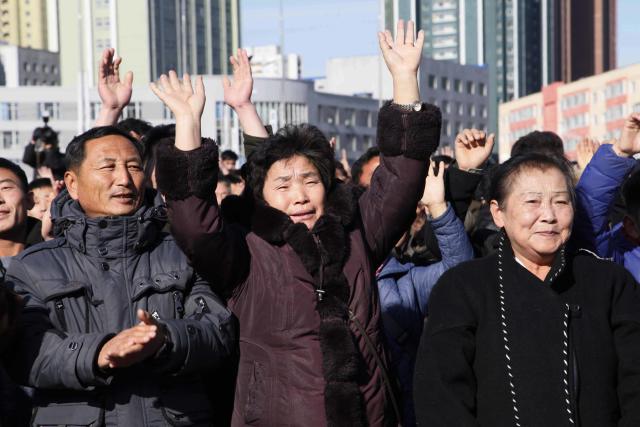Kathmandu:November 11/30/2017/ thursday/
The
Hague (AFP) - Dutch prosecutors are investigating how a Bosnian Croat
war criminal managed to dramatically take his own life Wednesday,
apparently after drinking poison he had smuggled into a UN court, in
scenes that were broadcast live.
In
shocking footage beamed around the world, Slobodan Praljak drank from a
small brown glass bottle and exclaimed he had taken poison moments
after UN judges upheld his 20-year jail term for atrocities committed
during the 1990s Balkans conflict.
The
72-year-old died in hospital after being rushed from the International
Criminal Tribunal for the former Yugoslavia (ICTY), casting a cloud over
what should have been a successful end to the court's tenure.
Prosecutors
said their investigation would focus on what killed Praljak and whether
he had received any outside help in obtaining the suspected poison.
"For
the time being the inquiry will focus on assisted suicide and violation
of the Medicines Act," the Public Prosecution Service said in a
statement late Wednesday, adding it would not be commenting further.
The
unprecedented drama came as judges handed down their very last verdict
at the court in the appeal case of six Bosnian Croat political and
military leaders.
Praljak,
a former military commander of a breakaway Bosnian Croat statelet,
shouted out angrily: "Praljak is not a criminal. I reject your verdict."
Standing
tall, with a shock of white hair and beard, he then raised a small
brown bottle to his lips, and tipped it into his mouth. The hearing was
quickly suspended as Praljak's lawyer interjected: "My client says he
has taken poison."
ICTY
spokesman Nenad Golcevski told reporters that Praljak "quickly fell
ill" and died in hospital. He could not confirm what was in the bottle.
The
stunning events caused a shockwave in Croatia and intense embarrassment
at a war crimes tribunal that closes next month more than two decades
after being set up at the height of the 1992-1995 Bosnian conflict.
Among the questions to be answered will be how he managed to evade tight security to smuggle the bottle into the tribunal.
And
if the liquid was indeed poison or noxious, how did he acquire it in
the UN detention centre in The Hague where he was being held?
- Moral injustice -
Croatia's Prime Minister Andrej Plenkovic slammed the "injustice" of the UN tribunal and expressed his condolences.
"His
act, which we all unfortunately witnessed today, speaks mostly about
the deep moral injustice towards six Croats from Bosnia and the Croatian
people," he told reporters.
Praljak's
act demonstrated "what sacrifice he was ready to make" to show he was
"not a war criminal," said Dragan Covic, the Croat member of Bosnia's
tripartite presidency.
"It is a humiliation of this institution which has existed since 1993."
Late
Wednesday candles were lit in the former breakaway statelet's capital
Mostar by Bosnian Croats and other residents in tribute to the late
general.
It is not the first time that defendants have taken their own lives at the ICTY.
Former
Croatian Serb leader Milan Babic killed himself in his cell at the UN
detention centre in 2006, after another Croatian Serb, Slavko
Dokmanovic, in 1998.
And
former Serbian president Slobodan Milosevic was found dead in his cell
in 2006 from natural causes before his trial could be completed.
- Serious crimes -
In
the complex ruling, the judges upheld the jail terms against all six
defendants, including a 25-year sentence imposed on Jadranko Prlic, the
former prime minister of the breakaway Bosnian Croat statelet, known as
Herzog-Bosna.
Praljak had been specifically charged with ordering the destruction of Mostar's 16th-century bridge in November 1993.
In
their ruling, the judges allowed part of Praljak's appeal, saying the
bridge had been "a military target at the time of the attack." But they
refused to reduce his overall sentence.
The
bloody 1992-1995 war in Bosnia, in which 100,000 people died and 2.2
million were displaced, mainly pitted Bosnian Muslims against Bosnian
Serbs, but also saw some brutal fighting between Bosnian Muslims and
Bosnian Croats after an initial alliance fell apart.
The
appeal judges said all six men, who had been found guilty of seeking to
remove Bosnian Muslims from the territory, "remained convicted of
numerous and very serious crimes".
In
statements sure to anger Zagreb, the judges upheld the original trial
finding that the men had been part of a joint criminal enterprise whose
"ultimate purpose was shared" by late Croatian president Franjo Tudjman,
and other leaders.
The aim of the scheme was to set up "a Croatian entity that ... facilitated the reunification of the Croatian people."
Terms ranging from 10 to 20 years were also upheld against the four other defendants.
Wednesday's
verdict comes a week after the judges imposed a life sentence on former
Bosnian Serb military commander Ratko Mladic.
His
judgement had also descended into confusion when he accused the judges
of lying and had to be dragged away into a nearby room.
The ICTY closes its doors on December 31, having indicted and dealt with 161 people.
By:Writter
Birbal Babu<<









